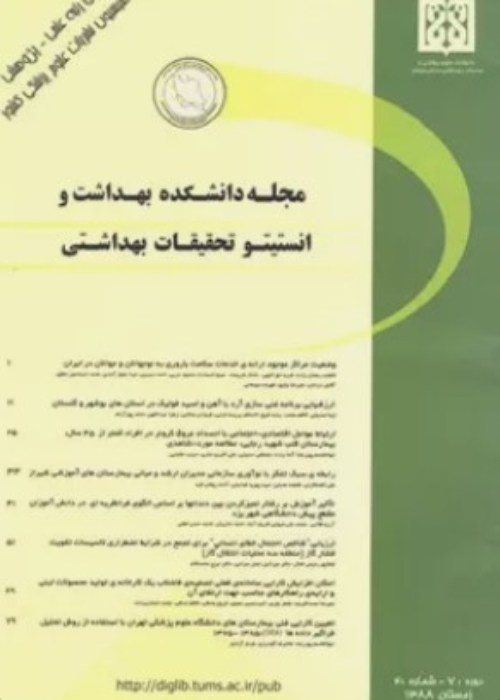Evaluating the Microbial Content of the Drinking Water in Rural Areas of Tehran Province
Author(s):
Abstract:
Background And Aim
The scattered state of the rural populations- in terms of both the distance between villages and the distance between residential units within a single village- has made the task of supply, distribution and monitoring the quality of water a difficult one. In this study we looked at the bacteriological quality as well as access to safe potable water in selected villages of Tehran Province. This research started in February 2006 and ended in July the same year.Materials And Methods
In this cross-sectional field study, sampling points were specified on the basis of the populations of the villages served by the Tehran Rural Water and Wastewater Company. After systematic sampling, the specimens were transferred to the laboratory for testing. Data were analyzed using the SPSS and Microsoft Excel software packages.Results
Drinking water contamination with E. coli was observed in 5.99% of the villages. The degree of contamination was highest in the districts of Pakdasht, Savojblagh and Damavand, with rates of 33.34, 13.69 and 13.32 percent respectively. For 99.36% of the Tehran rural population the turbidity was lower than the standard value of 1053 set by the Iranian Institute of Standards and Industrial Research. Values in Savojblagh and Varamin were relatively higher, with rates of 96.51% and 99.30% respectively. Given the standard value of 1053, the residual chlorine levels were unacceptably low for 92.39% of the rural residents, with figures in the districts of Pakdasht, Damavand and Robatkarim reaching 75.67, 85.45 and 83.98 percent respectively.Conclusion
Based on WHO guidelines concerning the microbial quality of water published in 2006, the average indicator for lack of E.coli in rural water of Tehran was 94.01%, i.e. at an excellent level. Levels were good for Damavand and Savojblagh, low in Pakdasht and excellent in all other districts.Language:
Persian
Published:
Scientific Journal of School of Public Health and Institute of Public Health Research, Volume:5 Issue: 4, 2008
Page:
63
magiran.com/p633795
دانلود و مطالعه متن این مقاله با یکی از روشهای زیر امکان پذیر است:
اشتراک شخصی
با عضویت و پرداخت آنلاین حق اشتراک یکساله به مبلغ 1,390,000ريال میتوانید 70 عنوان مطلب دانلود کنید!
اشتراک سازمانی
به کتابخانه دانشگاه یا محل کار خود پیشنهاد کنید تا اشتراک سازمانی این پایگاه را برای دسترسی نامحدود همه کاربران به متن مطالب تهیه نمایند!
توجه!
- حق عضویت دریافتی صرف حمایت از نشریات عضو و نگهداری، تکمیل و توسعه مگیران میشود.
- پرداخت حق اشتراک و دانلود مقالات اجازه بازنشر آن در سایر رسانههای چاپی و دیجیتال را به کاربر نمیدهد.
In order to view content subscription is required
Personal subscription
Subscribe magiran.com for 70 € euros via PayPal and download 70 articles during a year.
Organization subscription
Please contact us to subscribe your university or library for unlimited access!


